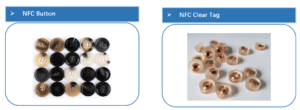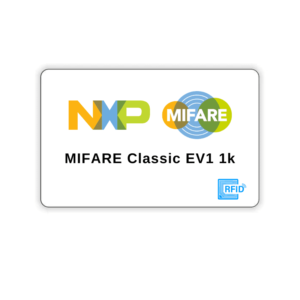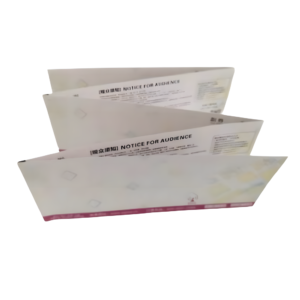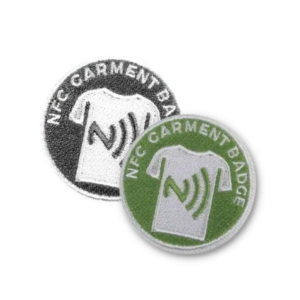5 Forum Types of NFC Tag
Communication (Proximity Wireless Communication) is a near-field wireless communication technology with a 13.56MHz frequency band that allows contactless point-to-point data transmission and exchange between electronic devices (within 10cm). We using NFC technology can exchange data close to each other, realize mobile payment, electronic ticketing, access control, mobile identification, security, and other applications. Simply said, the NFC tag is a small chip that can rub input, and you can write some personalized features into it. For example, you write a URL, phone number into, write well, when you want to open this URL or dial you to write in the phone number, you just need to put the NFC tag and your phone’s NFC sensing area, this URL or phone number will automatically appear on your phone, very convenient. NFC technology combines the Reader, tag, and peer-to-peer data exchange! NFC Forum, as the author of the specification, defines the following 5 types of NFC tags.
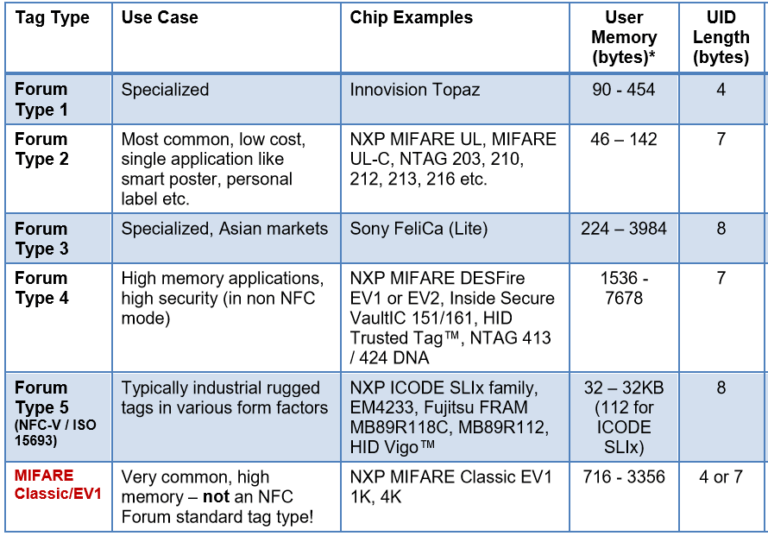
- Type 1: based on ISO14443A. With readable, re-write capabilities, which users can configure as read-only. The storage capacity is 96 bytes and is used to store URL or other small amounts of data. However, memory can be expanded to 2k bytes. The communication speed is 106 kbit/s. Typical representative chip Topaz 512 (BCM20203)
- Type 2: also based on ISO14443A, with readable, re-write capabilities that users can configure as read-only. It’s base memory size is 48 bytes, but can be expanded to 2k bytes. Communication speed is also 106 kbit/s. Typical representative chip,Mifare Ultralight, Ultralight C, NXP Ntag 203/210/213/215/216, etc.
- Type 3:based on FeliCa and is currently exclusively available from Sony. It has a larger memory (currently 2kbyte) and operates at a higher data rate (212kbit/s), which means it is suitable for more complex applications. Thus, the tag high costs.
- Type 4: it is defined as compatible with ISO14443A and B standards. Manufactured is pre-set to readable/rewritable, or read-only. The chip has a larger memory and is communicating between 106 kbit/s and 424 kbit/s. Typical chip types for a wide range of applications are the DESFire family, with capacities ranging from 2K, 4K, and 8K.
- Type 5: This type of tag is the latest type of NFC tag defined in recent years, and the corresponding RFID protocol is the ISO15693 series RFID chip. NFC Forum introduced this range of chips to meet the growing variety of long-distance, miniaturized NFC tags and their applications
* Note: the actual usable maximum size of NDEF text (e.g. a URL or plain text) is typically at least 7 bytes less than the available user memory specified by the chip vendor.
While tag types 1-4 exist since the early days of NFC definitions in ~2006, NFC forum added the ISO 15693 based Tag Type 5, in June 2015. This means in practice, that tag types 1-4 today are supported by typically all NFC devices, whereas tag type 5 needs to be tested. Typically Android, Windows Phone 10 and iOS ≥ 11 can work with type 5 tags. However, there may be differences in chip types. E.g. while the ISO 15693 chip ICODE SLIx from NXP works on all Samsung Galaxy phone models, including Android 4.x, other 15693 chips require Android 5.x to be properly recognized. iOS 11 requires iPhone 7 and an APP to be installed supporting read-only. Also MIFARE® Classic (not an NFC Forum tag type yet) is only supported by a few phones, depending on which NFC chipset is inside e.g. Samsung Galaxy S3 works well with MIFARE Classic, while Galaxy S4 to S9 do not support it. Most Windows phones support MIFARE Classic, but like type 5 tags, these tags must already contain NDEF formatted data that was written to the tag first in some other way before it can be used with Windows phones. Physical Form Factors of NFC Tags NFC – Elevating your proximity marketing efforts NFC tags can come in any form that is typically available for traditional RFID tags.


